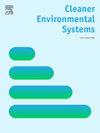Life cycle assessment and cost analysis of locally made solar powered cooler for vaccine storage
IF 4.9
Q2 ENGINEERING, ENVIRONMENTAL
引用次数: 0
Abstract
Storing vaccines and perishable food in regions without access to the national grid presents significant challenges. Solar power generation technologies have emerged as a viable alternative solution to address these issues. This study conducted a life cycle assessment (LCA) and cost analysis (CA) of the locally developed solar-powered cooler to assess its economic viability and potential environmental impacts. The cooler was designed to preserve vaccines and perishable foods for use, especially in areas with no electricity connectivity, as a cheaper alternative to electricity-powered coolers. The results of LCA show that battery manufacturing was a slightly higher contributor to environmental impacts across various indicators, with terrestrial ecotoxicity identified as the highest impact among other environmental impacts. Cost analysis results further revealed that a solar-powered cooler project demonstrated a positive economic outlook, with the unit manufacturing cost estimated at USD 2682. This quantitative analysis of life cycle and cost will help decision-makers comprehend both the economic aspects and environmental impacts throughout the life cycle of locally manufactured solar-powered coolers. Such insights will be instrumental in enhancing the sustainability of these products.
国产疫苗储存用太阳能冷却器的生命周期评估及成本分析
在无法接入国家电网的地区储存疫苗和易腐食品是一项重大挑战。太阳能发电技术已经成为解决这些问题的可行替代方案。本研究对自主研发的太阳能冷却器进行了生命周期评估(LCA)和成本分析(CA),以评估其经济可行性和潜在的环境影响。该冷却器的设计目的是保存疫苗和易腐食品,特别是在没有电力连接的地区,作为电力冷却器的一种更便宜的替代品。LCA的结果表明,电池制造对各种环境影响的贡献略高,其中陆地生态毒性被认为是其他环境影响中影响最大的。成本分析结果进一步显示,一个太阳能冷却器项目显示出积极的经济前景,单位制造成本估计为2682美元。这种对生命周期和成本的定量分析将有助于决策者了解当地制造的太阳能冷却器在整个生命周期中的经济方面和环境影响。这些见解将有助于提高这些产品的可持续性。
本文章由计算机程序翻译,如有差异,请以英文原文为准。
求助全文
约1分钟内获得全文
求助全文
来源期刊

Cleaner Environmental Systems
Environmental Science-Environmental Science (miscellaneous)
CiteScore
7.80
自引率
0.00%
发文量
32
审稿时长
52 days
 求助内容:
求助内容: 应助结果提醒方式:
应助结果提醒方式:


